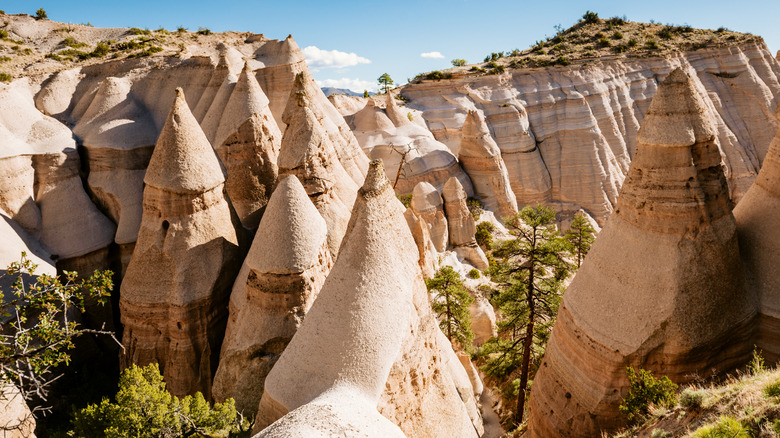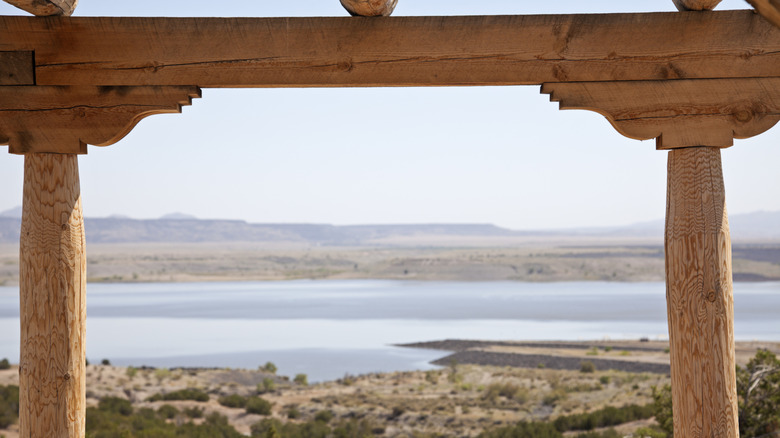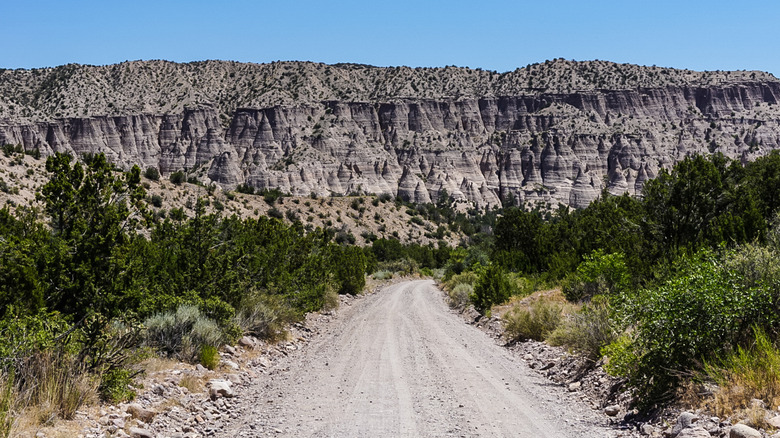Situated Between Albuquerque And Santa Fe Is New Mexico's Sacred Village With Art, Canyon Views, And History
For hundreds of years, Pueblo people lived across vast swaths of the Southwest, inhabiting ancient sites like Chaco Canyon, where striking ruins were once the largest buildings in North America. Their culture also spanned parts of modern-day Arizona and southwest Colorado, centering around structures like Mesa Verde's astonishing cliff dwellings, which comprise one of the U.S.' most underrated national parks today. Now concentrated predominantly in New Mexico, 19 pueblos are home to richly artistic Indigenous communities, each recognized as a sovereign nation. Among these historic villages is Cochiti, a pueblo that's home to around 1,500 residents.
Cochiti is the northernmost pueblo of people who speak Keres, or Keresan, a linguistic group comprising seven related languages spoken throughout the region. Cochiti Pueblo was called "ko-tyīt" in Keres, and it overlooks the Rio Grande. Over time, modern neighborhoods have evolved around a ceremonial plaza on the west side of town, which is home to a striking church called San Buenaventura de Cochiti, a number of adobe structures, and two ceremonial kivas that remain central to sacred events held to this day.
Cochiti is surrounded by incredible New Mexico desert, and it's also the gateway to the incredible Kasha-Katuwe Tent Rocks National Monument, which reopened in May 2025 after a four-year closure. If you love being outdoors and have your clubs in tow, check out Cochiti Golf Club, an 18-hole course near Cochiti Lake, and grab lunch at the adjacent Stone Kiva Restaurant.
Celebrate Native American arts and culture in Cochiti
Cochiti Pueblo is only 45 minutes by car from Santa Fe and just about an hour from Albuquerque. The pueblo is open to the public during the day, but as a community consisting of numerous private homes, visitors are asked to respect residents' space, and photography or recording of any kind is prohibited unless a permit is granted in advance. You can learn more about visiting the pueblo and attending cultural events at the Cochiti Visitor Center, which is also a great spot to purchase handcrafted pottery, jewelry, and drums.
Drums are central to Cochiti life, heard during the annual San Buenaventura Feast Day on July 14, among other events. The deep resonance characteristic of the instruments is achieved through time-honored methods of carefully selecting and carving aspen trees foraged from the nearby Jemez Mountains. Gilbert "Eagle" Herrera has been making drums for more than three decades. In Cochiti ceremonies, "you have the dancers, you have the singers, and you have the drum," Herrera said in an interview with The Center for Shamanic Education and Exchange. "There's that important triangle, and it is an essential part of the connection of the prayer of the ground directly straight up, where the prayers are carried up to the creator, usually by an eagle, which is special to all Natives in America."
Another facet of Cochiti artistry is the highly collectible ceramic Storyteller figure, thanks to a 1960s revival by artist Helen Cordero. In the early 20th century, Cochiti potters were making figurative sculptures of "singing mothers" that portrayed a woman holding one or two children. Cordero then created a larger figure holding numerous children, and the Storyteller tradition was born.
Look over Cochiti's canyons and hoodoos
Cochiti Visitor Center is your first port of call when you check in for your visit to nearby Kasha-Katuwe Tent Rocks National Monument, which requires reservations as of May 2025. Designated a national monument in 2001, the park is well worth a visit on your scenic desert road trip through this Southwest state. Kasha-Katuwe Tent Rocks sits about five miles northwest of the pueblo and is managed in conjunction with the Bureau of Land Management. Both a BLM permit reservation and a Cochiti Pueblo Tribal Access Pass are required to access the monument, with passes running $20 for those 17 and older and $10 for visitors 2 to 16 years old. As of this writing, the park is open Thursday to Monday, with entry between 8 a.m. and 1 p.m. and last departure at 4 p.m.
The geological wonders of Kasha-Katuwe Tent Rocks are well worth the journey. Once you've checked in, follow a pilot car into the park, where you can explore three trails with stunning canyon views. Grab the binoculars to identify red-tailed hawks, canyon wrens, spotted towhees, and hairy woodpeckers. And in the summer, look for Apache plumes, James' beardtongue, pale trumpets, and Western wallflowers.
The park's aptly named 1-mile Loop Trail takes you past the Veterans' Memorial Scenic Overlook in the northwest portion of the park. In the southeast area, hop on the Cave Loop Trail to see — you guessed it — a cave, and optionally, continue on via the 1-mile out-and-back Slot Canyon Trail. Pass remarkable hoodoos that in some instances reach up to 90 feet tall with their unique, namesake tent-like caps.


